Nutrition In Plants And Animals Introduction
- In our previous classes, we have learned about living and non-living things.
- Though there are many differences, a living organism shows seven basic characteristics that differentiate it from a non-living one.
- These characteristics are called life characteristics because together they ensure that an organism continues to live.
Read And Learn More: NEET Class7 Biology Notes
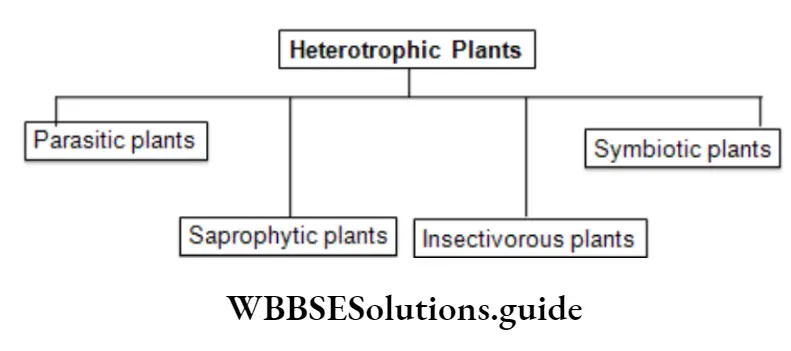
In this chapter, we will learn about nutrition, more specifically nutrition in plants. But, what does the term nutrition mean? Before, knowing about it, let’s know what food is.
Any substance that can be broken down through chemical processes in the body of an organism to give energy is called food Food gives energy to perform many activities like studying, playing, talking, drawing, etc
2. Nutrition
The entire process of taking in food and drink by living organisms and using it for the purpose of growth and daily activities is called Nutrition.
“class 7 nutrition in animals notes “
There are two major modes of nutrition:
- Autotrophic nutrition
- Heterotrophic nutrition
Autotrophic Nutrition
- We have seen animals and humans eating food. We get energy from the food we eat. How about plants?
- Neither they can cook food nor they can to different places like animals in search of food.
- How then are they preparing food?
Photosynthesis
- Green plants actually make their own food through a process called photosynthesis (photo, light; synthesis, to put together).
- The mode of nutrition whereby a living organism makes its own food is called autotrophic nutrition.
- Organisms that are able to synthesize their own food are termed autotrophs (auto, self; trophy, nutrition).
The term photosynthesis was coined by Charles Reid Barnes in 1883.
- It is a process in which carbon dioxide from the atmosphere is taken in by the leaves.
- Water absorbed by the roots reacts with carbon dioxide in the presence of sunlight to produce starch and oxygen.
- The starch is stored in various parts of the plant and oxygen is released into the atmosphere.
- The reaction that takes place can be written as:
- Carbon dioxide + Water sunlight Starch + Oxygen and chlorophyll
“class 7th chapter 2 science notes “
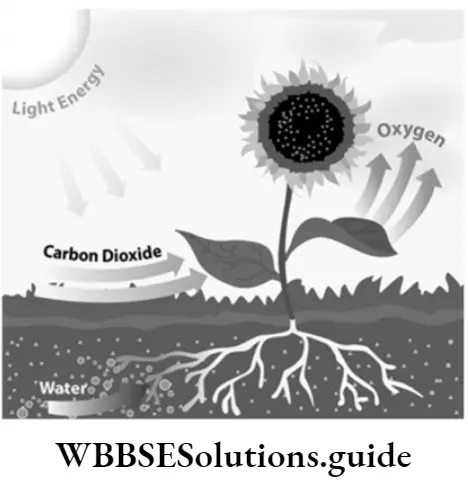
Thus, photosynthesis can be defined as:
The process of using the energy in sunlight to convert water and carbon dioxide into carbohydrates (starch) and oxygen is called Photosynthesis.
Photosynthesis – Necessary Conditions
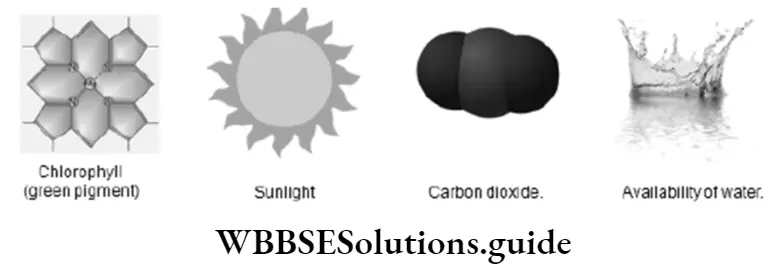
Chlorophyll
It is a green pigment present in the structures called chloroplasts of leaves in a plant.
Note:
A naturally occurring substance that gives a particular color to a plant or an animal part is called a pigment. On average, there are about 500,000 chloroplasts per square millimeter of a leaf.
Sunlight
It is the source of light energy required for photosynthesis. Chlorophyll traps the light energy to make energy-carrying particles.
“nutrition in animals diagram “
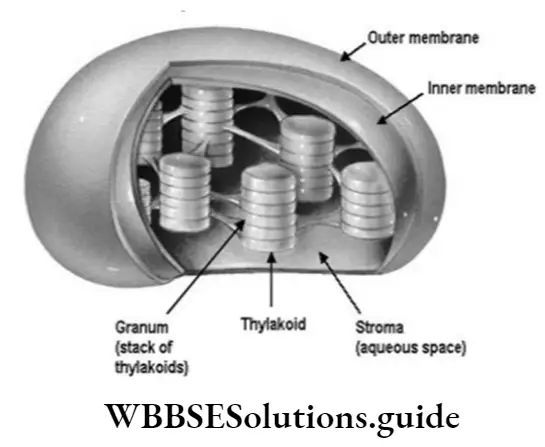
Carbon dioxide
It is obtained from the atmosphere through small openings called stomata (singular: stoma) in the underside of the leaves.
Water
This is another important requirement for photosynthesis. The root system of plants enables them to obtain water from the soil.
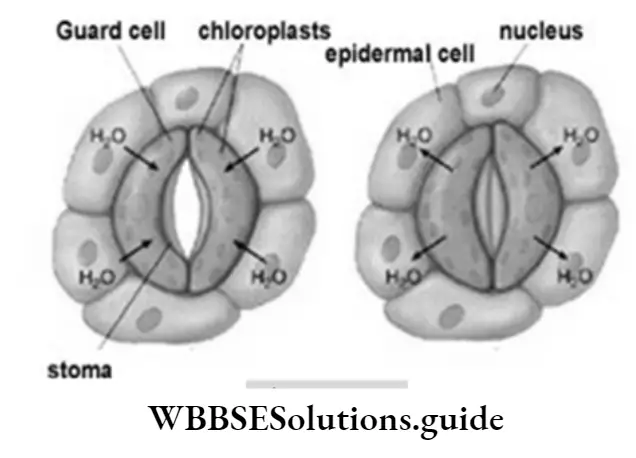
Factors Affecting Photosynthesis
The following factors affect the rate of photosynthesis:
- Light intensity: Photosynthesis increases with an increase in light intensity, up to a certain point.
- Availability of carbon dioxide: Photosynthesis increases with an increase in carbon dioxide concentration.
- Temperature: Upto a certain temperature value, the rate increases with an increase in temperature. This value ranges generally between 20° to 35°C.
- Availability of water: Less availability of water reduces photosynthesis through the closure of stomata.
- Inorganic mineral ions: A dehydrated green plant (a plant from which all water has been removed) consists of four elements – carbon, hydrogen, oxygen, and nitrogen.
“class 7 science chapter 2 notes pdf “
These elements consist of about 96% of the total plant’s dry weight combined together in the form of organic compounds (proteins, carbohydrates, fats, etc.).
The remaining 4% of the green plant dry weight consists of the following chemical elements in the form of inorganic compounds – sulfur, phosphorus, calcium, iron, magnesium, potassium, chlorine, aluminum, boron, manganese, copper, zinc, and chlorine.
These elements are obtained from soil water, and taken up through the root system as ions. Each of the inorganic ions has different functions in the process of photosynthesis.
Some of the elements are required in higher quantities (called macronutrients) while others are required in lower quantities (called micronutrients or trace nutrients).
Macronutrients: Carbon, hydrogen, oxygen, nitrogen, phosphorus, sulfur, potassium, calcium, iron and magnesium.
Micronutrients: Copper, zinc, boron, manganese, and molybdenum.
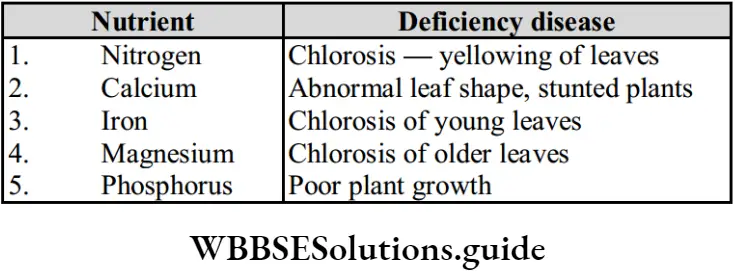
3. Transport Of Materials
There are two aspects of transport in plants:
- Movement of water and minerals from the roots upwards to other plant parts, and
- Movement of food material synthesized in the leaves to other plant parts. Upward movement of water and minerals occurs through channels, called xylem elements, present in the roots, stems, and leaves of plants.
The prepared food material in a soluble form is carried through another channel, called phloem, from the leaves to all other parts of the body.
Demonstration Of Upward Movement Of Water
- Take a cut shoot of the balsam plant and dip it in a dilute red-colored dye, eosin, or safranin. Leave it for some time.
- Then, take sections from different parts of the stem starting from the tip region. You will observe red color dye in the region of the xylem
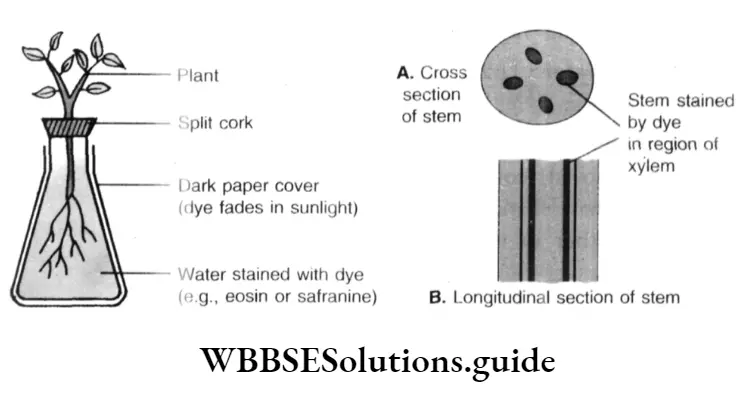
Demonstration Of The Transport Of Food Material
- This is easily demonstrated by an experiment commonly known as the ‘girdling experiment’. Girdling of the stem removes phloem tissue.
- If a stem is girdled, the downward and upward movement of food material gets blocked. So, the trunk portion shows swelling in the area due to the accumulation of food material.
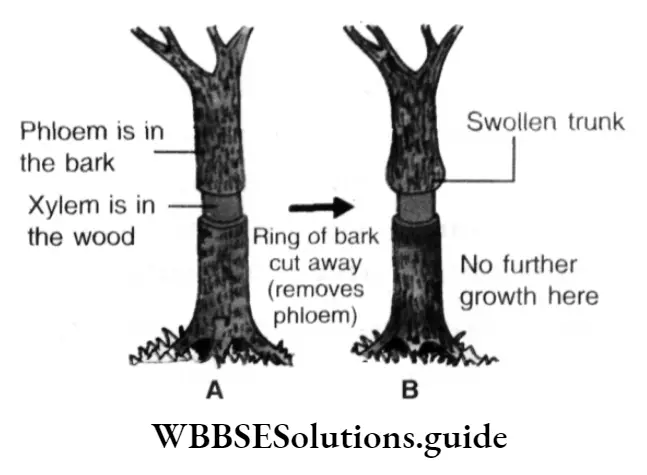
Heterotrophic Nutrition
- Most of the plants on the Earth are green. But there are certain plants that do not contain chlorophyll, neither in their leaves nor in any other part.
- Such plants, called non-green plants, are unable to prepare their own food. Such plants depend on green plants or on other living bodies for their nutrition.
- The mode of nutrition in which organisms cannot manufacture food and have to depend upon other plants and animals to obtain energy is called heterotrophic nutrition.
- Organisms that have a heterotrophic mode of nutrition are called heterotrophs [heteron, (an)other; trophe, nutrition].
According to the mode of nutrition, heterotrophic plants are of the following types:
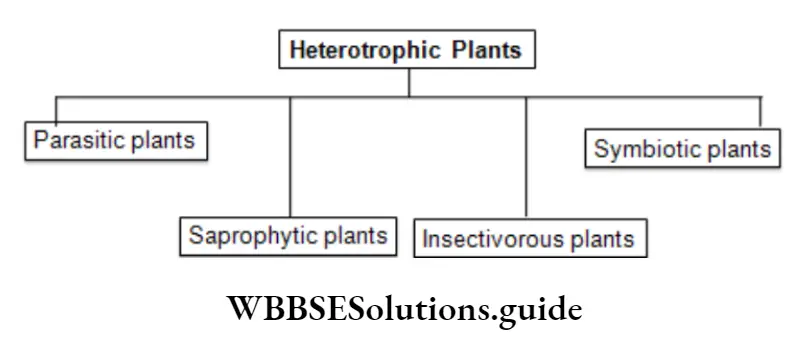
Parasitic Plants
- Parasitic plants are those which absorb food from another growing green plant, called the host.
- Usually, parasitic plants develop special roots which penetrate into the tissues of the host plant. The prepared food is generally absorbed from the root or the stem of the host plant.
- Mistletoe has leathery, green leaves, so they can make their own food but they depend on the host for minerals and water.
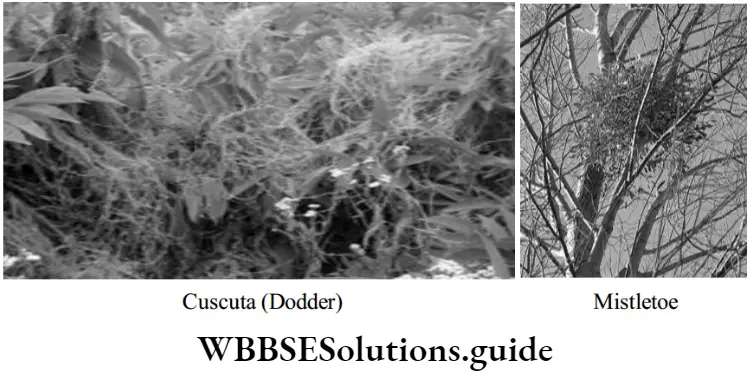
Cuscuta (Dodder) has a short root and a long, thread-like stem. It twines around the host stem and sends branches around neighbouring stems giving the appearance of a mass of noodles or spaghetti.
An Interesting Fact
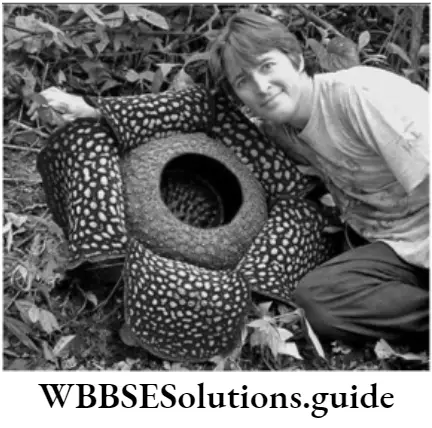
A parasitic plant, Rafflesia, bears the world’s largest flower.
The flowers have five petals may have a diameter of up to 106 cm, and weigh up to 10 kg. In a parasitic relationship, only the parasitic plant benefits.
Does a parasitic do any harm to the host plant?
- Parasitic plants harm the host plant. Dodder and mistletoe are serious problems for plants. Dodder can cover woody plants and cause heavy damage to certain economically important crops.
- Mistletoe can become so abundant on a tree that most of the foliage is of the parasite and not of the host.
Does this mean that the host plant is slowly killed off by the parasite?
Scientists believe that parasitic plants rarely, perhaps never, kill the host plant, so that the parasite can continue to live off the host.
Saprophytic Plants
Saprophytic plants are usually whitish but can have brightly colored flowers. These plants have no green leaves; often they even have no leaves at all. So, how do saprophytic plants manage their nutrition?
Saprophytic plants are plants that live off rotting material (sapros, rotting; phyton, plant). They grow in places with lots of rotting dead leaves, often in deep shade in tropical forests. Some examples are
- Indian Pipe and coral root.
- Indian Pipe is found commonly in Asia and throughout North America.
- Coral roots are found in forest environments around the world.
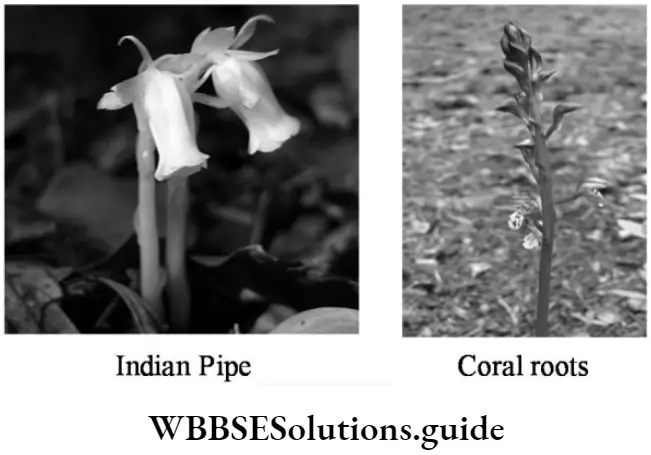
The roots of saprophytes contain living organisms called fungi.
Fungi are capable of digesting dead and decaying matter. The fungi produce digestive juices which convert the dead and decaying matter into sugar which can be then used as food by these plants. Fungi are also called saprotrophs.
Interesting Point
According to the latest system of classification of organisms, fungi are no longer considered in the plant kingdom. It is placed in a separate kingdom — Kingdom Fungi.
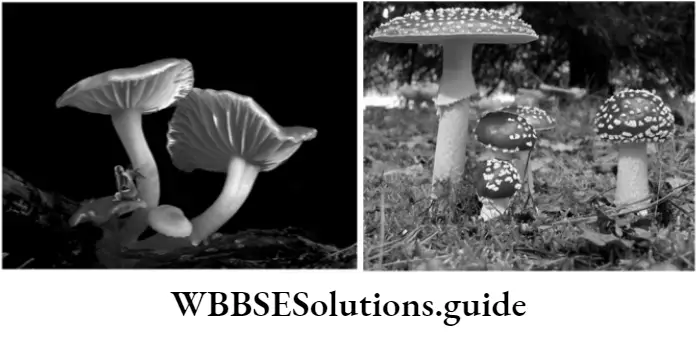
Mushrooms and toadstools are the most common examples of fungi
Insectivorous Plants
- These plants are usually green so they can make their own food.
- However, the soil in which they grow is sometimes deficient in certain nutrients, especially nitrogen.
- Hence, these plants need to obtain these nutrients from outside sources.
- Insectivorous plants are plants that derive some or most of their nutrients by trapping and consuming animals, mainly insects.

Examples:
- In the pitcher plant, the leaf is modified to form a tubular pitcher-like structure.
- The inside of the pitcher is lined with downward-pointing hairs. These hairs do not allow any insect to climb back up and escape.
- The fluid at the bottom of the pitcher contains digestive juices that digest the insect.
- The slender leaves of bladderworts bear a large number of very small, pear-shaped bladders.
- This opens a trapdoor and the prey is sucked in within one-thousandth of a second
- The leaves of sundew (Drosera) have tentacles with drops of a sticky substance called mucilage at the ends; insects get stuck in this substance and become entangled.
- The helpless insect then gets digested.
- The trap of Venus flytrap is a highly modified leaf. On the inner surface (reddish here to attract insects) there are short, stiff hairs. When anything touches these hairs, the two lobes of the leaves snap shut in less than a second,
Symbiotic Plants
There are certain plants that live in association with other species and share their food resources.
Both types mutually gain from each other. Such plants are called symbiotic plants and the relationship is called symbiosis. A good example is lichens.
- Lichens are an association between a fungus and a microscopic plant — green algae. The fungus obtains nutrients from the algae, and the fungus in turn provides shelter to the algae so that it can grow in harsh conditions like rock surfaces where it would otherwise not survive.
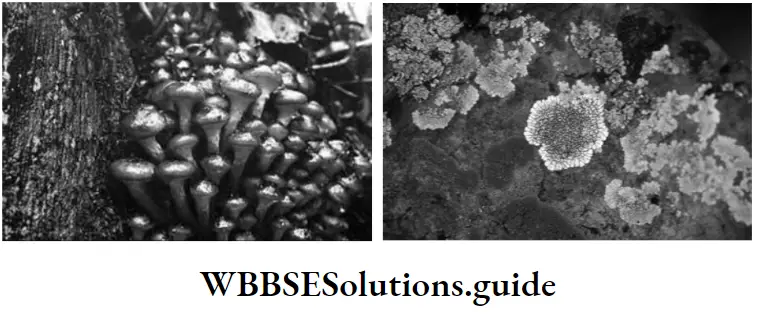
- Roots of certain plants such as peas contain bacteria called Rhizobium. It converts atmospheric nitrogen into plant-usable forms, e.g., ammonia. The plant in turn provides nutrients for the bacteria’s growth.
Replenishment of Nutrients in the Soil
Plants utilize the mineral nutrients, especially nitrogen present in the soil, for their growth. As a result, there is a depletion of nitrogen in the soil over a period of time. Manure contains a lot of nitrogen apart from potassium and phosphorus. This is needed by the plant for healthy growth.
5 Components Of Food — Nutrients In Food
There are seven essential components or substances called nutrients in our food. These are:
- Carbohydrates
- Fats
- Proteins
- Mineral salts
- Vitamins
- Water
- Roughage (Fibre)
Of these carbohydrates, proteins, and fats are the three main components.
Carbohydrates
These are the common energy-giving compounds. Foods rich in carbohydrates are potato, sweet potato, bread, rice, wheat, honey, common sugar, jaggery (gur), and milk.
Most processed foods like pizza, burgers, jams, jellies, and noodles are rich in carbohydrates.
Macronutrients
Nutrients that are required by our body in large amounts and form the bulk of our diet are called macronutrients. Carbohydrates, fats, and proteins are macronutrients
Fats
These are also energy-giving foods, producing more energy than carbohydrates. Fat-rich foods are
- Milk Products Such As Butter And Cheese,
- Vegetable Oils Such As Coconut Oil, Groundnut Oil,
- Nuts,
- Milk And
- Animal fat from meat.
Fats provide more than double the energy provided by carbohydrates or proteins.
Proteins
These are body-building foods. Proteins help the body in its growth and repair of body cells and tissues, protect and help the body fight against infections, and regulate body functions.
Protein sources of plant origin include pulses (soybean, peas) and to a lesser extent cereals. Meat, eggs, cheese, milk, and fish provide proteins of animal origin.
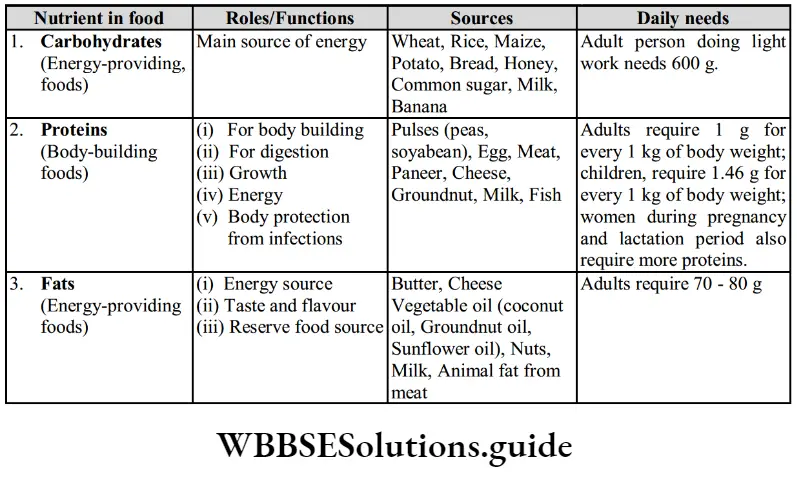
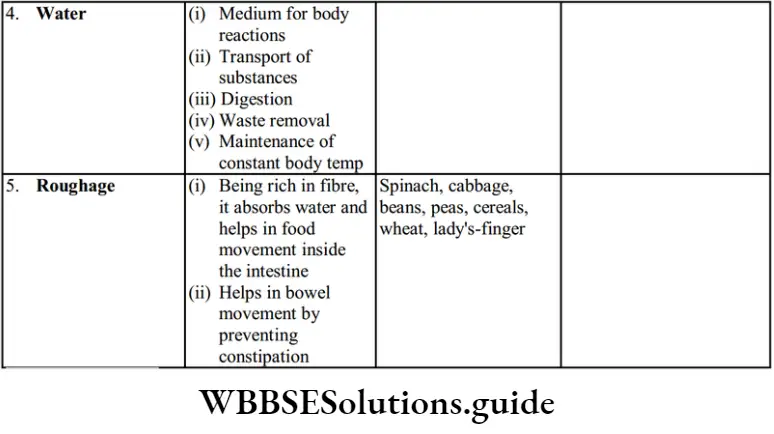
Mineral Salts
- Mineral salts are important for various body functions. They are required in small quantities and are obtained from the food we take in.
- Minerals have no energy value. Rich sources are milk, cheese, green leafy vegetables (like spinach), pulses, meat, and eggs.
- Salts of calcium and phosphorus are required for making bones and teeth hard and for promoting blood clotting. Iron is essential for forming hemoglobin, a component of our blood, the deficiency of which causes anemia.
- Green leafy vegetables, eggs, groundnuts, and liver are good sources of iron. Iodine, another mineral, controls the functioning of an important gland, the thyroid.
- Deficiency of iodine leads to goiter. Iodized salt, fish, and seafood are the sources of this mineral.
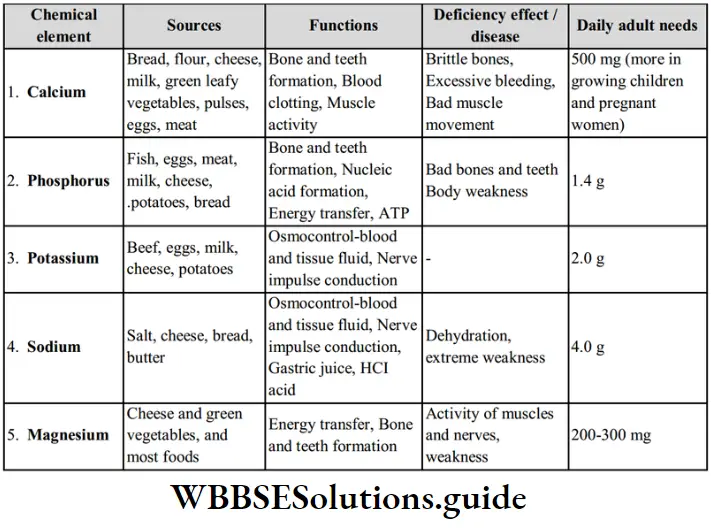
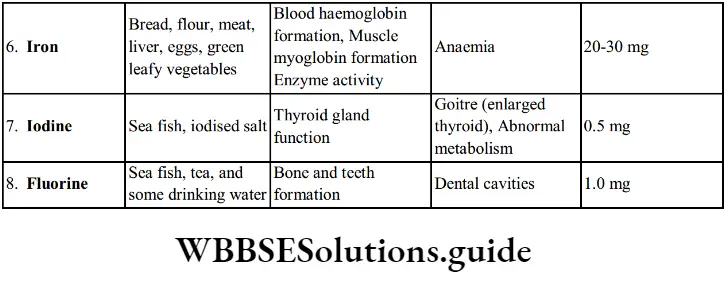
Vitamins
Vitamins are neither body-building nor energy-giving foods but are very important for the proper functioning of our bodies. They are required by the body in very small quantities. Green leafy vegetables, fruits, milk, eggs, and cheese are rich in vitamins.
Micronutrients
Nutrients that are required by our body in small quantities are called micronutrients. Vitamins and minerals are the micronutrients in our food.
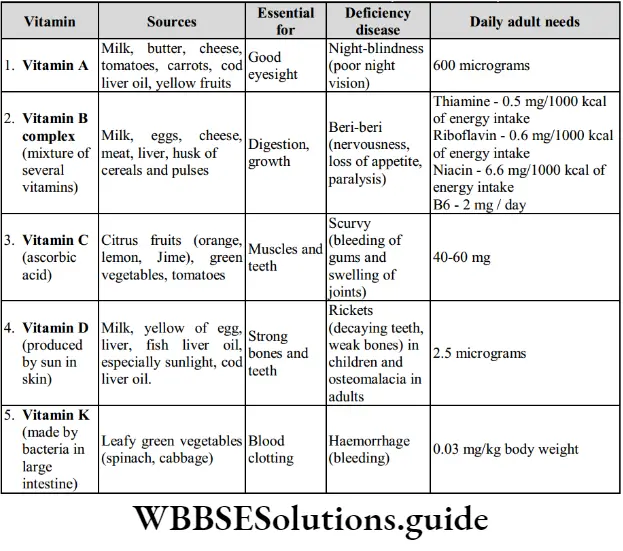
Water
- Water is indispensable. About 70 percent of our body weight is that of water. It helps the body in various functions. It is a means of transporting substances in the organism. It helps to maintain a constant body temperature.
- Water helps in the absorption of food and excretion of waste products from the body. Our body needs 2-3 liters of water every day.
- Many invertebrates, some birds, and desert animals do not need to drink water as they produce enough ‘metabolic’ water for their use from the breakdown of the food they consume.
Roughage (Fibre)
Fibre is found in vegetables, fruits, beans, and cereals. It has no nutritive value, but prevents constipation and is necessary for proper functioning of the digestive system.
6. Types Of Food Based On Their Role
Foods, on the basis of their role in the body, are classified into three major food groups:
- Energy-Giving Foods (Like Carbohydrates And Fats)
- Body-Building Or Growth-Promoting Foods (Like Proteins), And
- Protective foods (vitamins and minerals).
No single food can supply all the components required for proper nutrition. Food items included under these three food groups are given in Table 5.4 and shown in
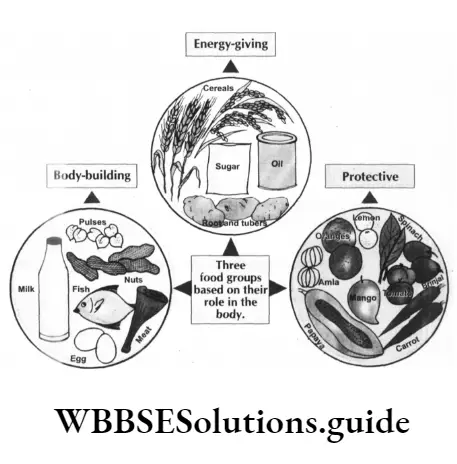
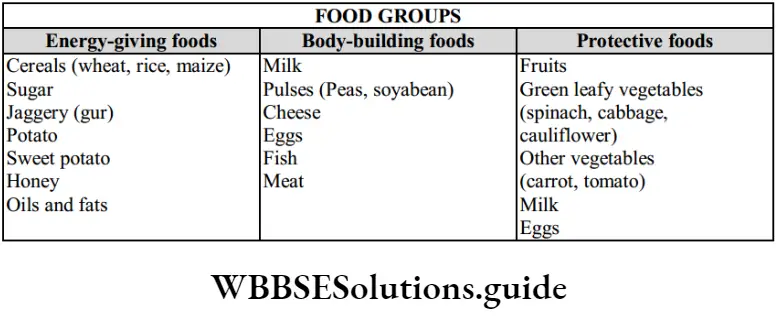
7. Composition Of Some Food Items
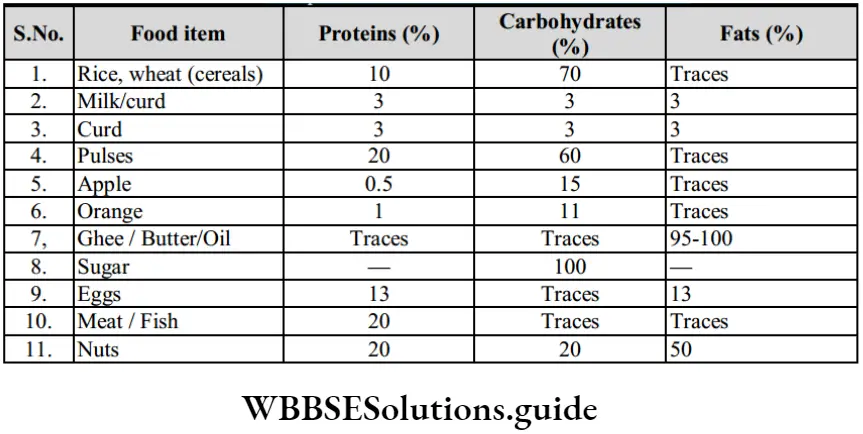
8. Foods And Their Energy Values
When food is eaten, it is broken down into simpler compounds, and in this process, energy is produced. The energy-producing life function in living organisms is known as respiration.
For instance, when sugar, a simple form of carbohydrate, is burned in the air, it produces heat and light as energy. Carbon dioxide and water are also produced as by-products.
Sugar + Oxygen → Carbon dioxide + Water + Energy
C12H22O11 + 12O2 → 12CO2 + 11H2O + Energy
A similar reaction takes place if glucose is burnt in place of sugar.
C6H12O6 + 6O2 →6CO2 + 6H2O + Energy Glucose
This process occurs inside our body too, during the process of respiration, but with the following modifications:
- Inside the body, the breakdown of glucose or sugar does not take place in one step as in burning. Instead, it occurs in several steps.
- Secondly, the energy is also released in small packets, without raising body temperature.
- Thirdly, inside the body, certain protein molecules, called enzymes, take part in the process of breaking down food molecules. This does not happen in burning.
Thus, one of the major functions of food is to produce energy.
Different foods produce different quantities of energy. The energy in foods is measured by a unit called calories.
Note:
- 1 kilocalorie (kcal) = 1000 calories
- 1 calorie =4.18 joule 1000 joules = 1 kilojoule (kJ)
The energy value of foods
- Fats: 9 kcal/gram or 37 kilojoules
- Carbohydrates: 4 kcal/gram or 17 kilojoules
- Proteins: 4 kcal/gram or 17 kilojoules
Water is the only nutrient that supplies no energy.
Calorific values of some individual food items are given in Table.
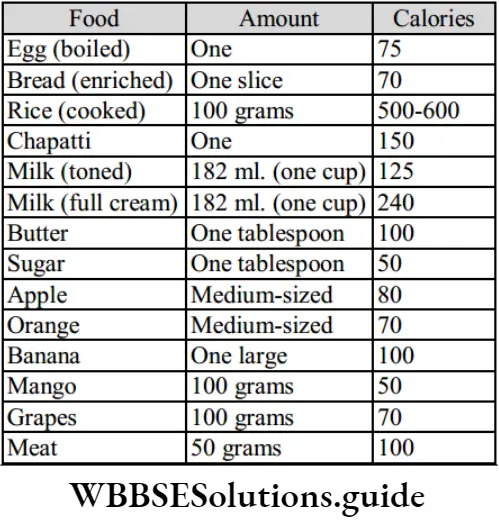
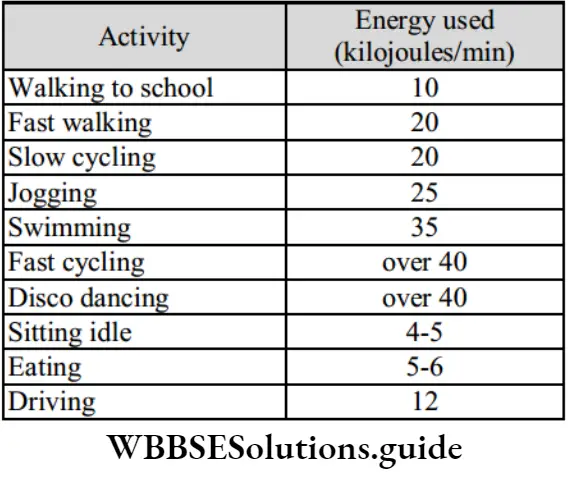
Who Needs More Food?
- A person doing hard physical work requires more energy. So, a greater carbohydrate content is required.
- Pregnant women need more nutrients. The child growing inside, needs
- Proteins For Growth,
- Calcium For The Bones,
- Iron for the blood.
- For breastfeeding the baby, the nursing mothers need more of
- Calcium
- Protein-Rich Milk
- Vitamins.
Growing children need more food in proportion to their body weight to know how much energy is spent on different activities that children generally perform.
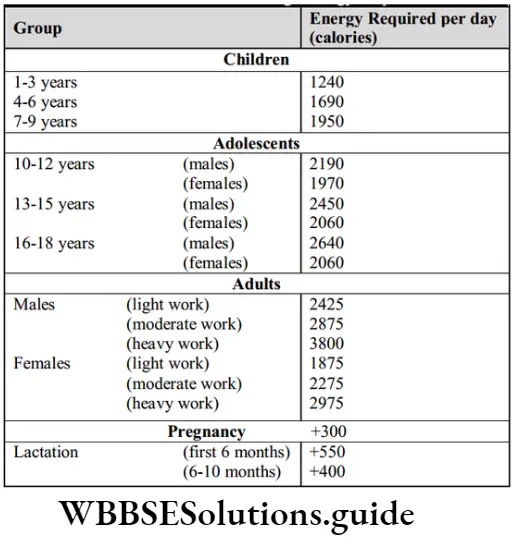
Different people need different amounts of food energy. Their calorie needs are different. Some people need more calories than others.
The number of calories a person needs depends on many things. Here are a few:
Age: Young people need extra energy because they are very active. Extra calories are also needed for their growth.
Weight and Size: Tall people need more calories than small ones.
Activity: An active adult needs more calories than an inactive adult. For example, a laborer needs more calories than a clerk. Adults who play sports need extra calories.
Temperature: The body uses energy to maintain a normal temperature. In cold climates, extra calories are required to maintain this temperature.
9. Balanced Diet
- Our body requires balanced quantities of proteins, carbohydrates, fats, vitamins, and minerals for its proper growth and maintenance.
- Deficiency of one or the other nutrient in the food leads to poor health and makes it prone to disease.
- Deficiency of food in terms of quantity, or undernutrition as it is called, may lead to starvation.
- An inadequate diet results in the loss of weight, and the person’s digestive system is affected. Often a person suffers from diseases due to improper intake of food.
- The food taken in may be deficient in essential nutrients due to wrong food habits. This is known as malnutrition.
“class 7th science chapter 2 diagram “
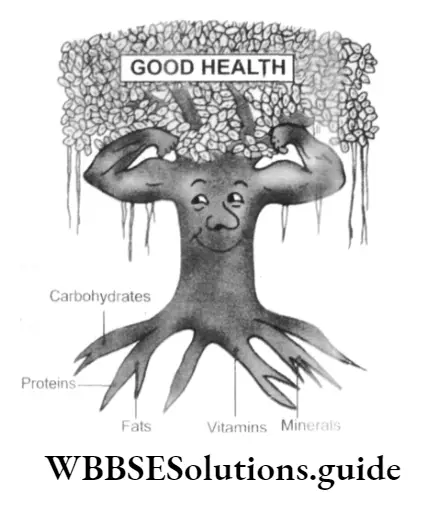
Some eat only rice while others prefer chapatis or bread. Illiteracy adds to the problem.
A mixed diet containing all the essential nutrients in the right proportion is necessary for the body’s proper growth.
Such a diet is known as a balanced diet. A balanced diet, thus, provides the body with
- All The Essential Nutrients,
- All The Materials Necessary For Proper Growth And Repair Of Body,
- Energy Required By The Body To Carry Out Its Life Activities, And
- Extra nutrients to withstand short periods of fasting.
Over-eating may also lead to diseases. Obesity is one such disease.
This often leads to other problems like heart disease and high blood pressure.
Also, a balanced diet is related to one’s age, health, and occupation. For example, a labourer needs more carbohydrates and fats in his diet which would provide him more energy. A young child should take more proteins, as they help in bodybuilding.
10. Food Additives
When some foods are manufactured, chemicals are put in them. These chemicals are called food additives.
Food additives have no nutritional value. They are added for a number of reasons.
- Colorings: These make the food look more attractive. Tinned peas and arid strawberries, for example, owe their color to these chemicals.
- As preservatives: These slow down the rate at which foods go bad and keep the food fresh. Thus, the foods can be carried over long distances.
- As flavorings: These restore the flavor of the food that is often lost when it is processed. Most additives are harmless. Some additives may cause headaches, asthma, damage to organs such as the liver and kidneys, and even cancer.
11 . Food Fads
- Food forms an essential part of our daily life. A considerable part of our time and money is spent on selecting and purchasing foods.
- We are exposed to a variety of information and views about foods and their nutritional value through newspapers, magazines, books, advertisements, and conversation.
- Our views are influenced by what we hear and see. Very often, expensive foods are considered more nutritious and good for health than less expensive foods.
- Similarly, foods that are difficult to obtain are considered better than easily available ones. Such wrong notions prevail in our society.
- Misinformation or wrong and unscientific information about food is termed food fads.
- Some of the food fads have arisen due to certain customs, traditions, and wrong beliefs.
Expensive vs. inexpensive food – grapes vs. spinach
- Let us take the example of two food items — the expensive grapes and the inexpensive leafy green vegetable spinach (palak).
- The nutrients present in 100 grams of grapes and spinach are listed in the given table.
- Spinach contains much more proteins, fats, minerals, and vitamins than grapes. It clearly proves that spinach is more nutritious than the costlier grapes.
- Similarly, cheaper fruits like bananas and guavas have a greater nutritive value than more expensive fruits like grapes and pomegranates.
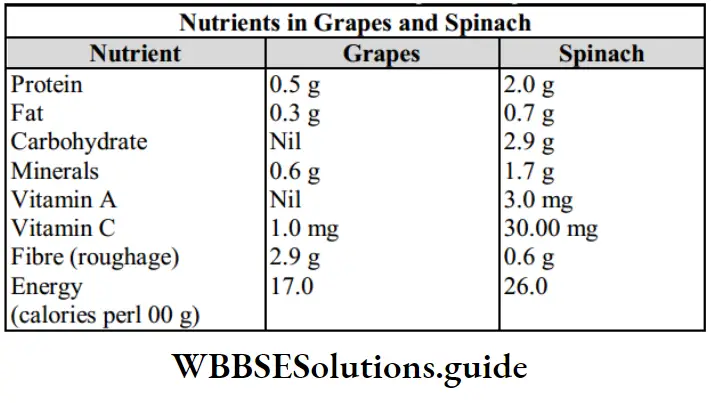
Food Fads About Cereals And Cereal Products
1. There is a wrong notion that starchy foods, such as rice and bread, are rich in calories.
- In an attempt to reduce weight, many persons reduce or cut down their intake of cereals from their diet.
- What is to be remembered is that cereal foods such as chapatti or bread are not a very high source of energy.
- The calories come from the foods added to them such as ghee, butter, cheese, jam, sugar and chutney etc. It is these high-calorie foods that need to be avoided.
2. Another wrong notion is that weight reduction is possible by eating bread or chapatti instead of rice.
- It is well known that both rice and wheat contain about the same number of calories, so eating one and leaving the other one will not make any difference. It is the total calorie intake that needs to be reduced for effective weight reduction.
Food Fads About Oils And Fats
- Some manufacturers claim and suggest that people should use a particular brand of vegetable oil, as it has a high content of polyunsaturated fatty acids (PUFA) contains no cholesterol, and is thus beneficial for heart patients.
- The fact is that all vegetable oils (except olive and coconut oils) contain a high amount of PUFA and also do not contain any cholesterol.
- Stating that a particular brand of vegetable oil contains no cholesterol is intended to misguide the layman to think that other brands of vegetable oils contain cholesterol.
- These claims make a person feel that he can safely consume as much oil as he wants without any problem.
Food Fads About White Eggs And Bhlndl
- White eggs are better than brown ones. There is no truth in it. Both types of eggs have the same amount of nutrients.
- Eating bhindi (lady’s-finger) makes a student good at mathematics. There is no truth in this belief.
12. Good Food Habits
To maintain good health, we need to develop and maintain good food habits. These include:
- Eat a balanced diet, keeping in mind your age, health, and occupation.
- Eat clean food, and keep protected from dust, house flies, and mosquitoes.
- Eat properly cooked fresh food.
- Avoid fried foods as far as possible.
- Use clean utensils.
- Take adequate amounts of green salad, green vegetables, and fruits in your diet.
- Consume simple digestible food.
- Drink large quantities of clean filtered water.
- Chew food well.
